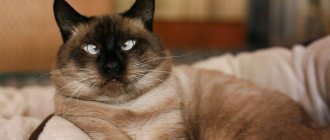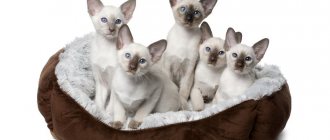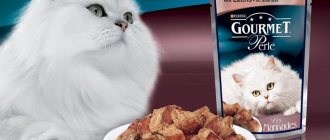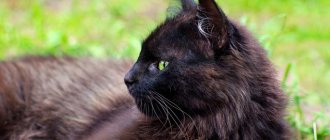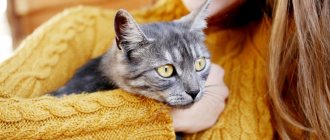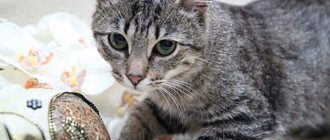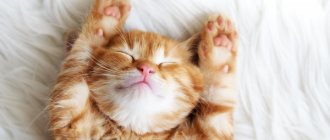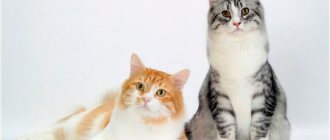Home » Breeds » About the Himalayan cat breed
The Himalayan cat has no relation to either the Himalayan mountains or the Himalayan bears. Bears generally belong to the mustelidae family (“Mustela et familia” in Latin), while the Himalayan cat belongs to Felis catus (“Felids”). And the color of black bears and color-pointed cats is different: the bear is solid black with a white dewlap - a “swallow” on the chest, while the Himalayan cats, on the contrary, have a light body with a contrasting point on the muzzles, tails and paws. And the name of the cats did not come from bears, but from rabbits - color-pointed Himalayans, which have a light body and dark spots. These rabbits have another name - Russian ermines (white fur + black nose and tail), but what is definitely not in the Himalayan cat is an influx of blood either from Russian cats or from any rabbits.
So, the name “Himalayan cat” refers only to the color of the light body in combination with points on the face, paws and tail. Himalayan cat photo.
History of cats and their breeds
Cats and cats are creatures of nature, and their preferences are natural. To procreate, they choose a couple based on certain criteria, where strength, endurance and health come first, and only then external data. The domestication of cats began about ten thousand years ago, and at that time all cats did not have a specific breed, but living in different areas, they differed in appearance and character.
As cats from different areas spread throughout the world, they crossed with each other and the first mestizos appeared, which, in turn, continued to reproduce. This is how modern cats appeared, which differed in physique, length and color of fur, and character. With the development of progress, the study of genetics began and the identification of the causes of differences in the color and character of pets began, as well as their unification into separate groups - breeds.
All breeds have their stories:
- Some arose naturally without human intervention, such as the Siamese cat.
- Others are bred artificially, through long-term crossings of different species. One of the representatives is British. In fact, this is a mixed-breed cat whose parents were English and Persian domestic cats.
- For still others, the main distinguishing feature of the breed is caused by a gene mutation, for example, in Scottish cats it is folded ears. Subsequent work was aimed at preserving such features.
Today there are more than 400 cat breeds.
Mixed cats
Despite the fact that kittens from representatives of various breeds can be bright, graceful and funny, mixed breeds will never become the owners of a pedigree and will not take first places at exhibitions.
Mixed-breed cat - what is it? The answer to this question is known to every breeder, who mercilessly cull kittens born from different breeds. But many modern breeds appeared through random crossing. This is how the Broomilla breed arose from a Persian father and a Bruma mother. The first offspring was not considered a breed, but thanks to the work of the breeder, who continued to work on improving the new species, the Broomilla was recognized and included in the International Register of Pedigree Cats.
Diseases of the breed
Unfortunately, from their Persians and Siamese, the Himalayan cat breed inherited breathing problems, lacrimation and polycystic kidney failure.
A conscientious breeder will definitely identify this genetic disease and provide you with documents confirming its absence among his breeders.
In general, any good breeder is proud of his animals and will be happy to show you not only the mother and father themselves, but also documents, awards and even just photographs of his pets. Looking at the documents and these pictures, you can make sure that you are buying exactly the animal you wanted, and not a “pig in a poke.” And this is what your “boy” will look like when he grows up. Himalayan cat photo.
A decent breeder is very proud of his sires and will show them to you with great pleasure, be sure to tell you about championship titles, and present documents confirming the pedigree. By watching and listening to the kittens' parents, you will find out what your kitten will look like when it becomes a big cat.
Métis British
Mixed breed cats have always existed, and the British are no exception. The history of their origin began with the islands of Britain, where imported Persians were crossed with local representatives - English domestic cats. The new breed was called British. She combined English intelligence and Persian proud stubbornness.
To obtain new colors, breeders crossed this breed with their relatives, the Persians. As a result of their labors, a mixed breed of British and Persian was born. The breeding of such mestizos continued until 2003, after which it was prohibited due to signs of degeneracy in both breeds. Today, a kitten from a Persian cat and a British cat is characterized as outbred and does not receive places at exhibitions.
Also relevant were the matings of British and Scottish shorthair cats, which were used to breed Scottish Folds or Scottish Folds. Since lop ears are caused by a mutating gene, mating of two mutants is prohibited due to the risk of hereditary diseases and skeletal deformities incompatible with life in the offspring.
Keeping a Himalayan cat at home
The breed is suitable for home keeping. A calm disposition and playful character will make you a great friend. Suitable for families who spend a lot of time at home, as they do not like being alone. It must be taken into account that the animal is afraid of closed spaces, so you should not lock it in a small room.
The disadvantages include the presence of long hair, but with proper care it will not cause problems.
Care and hygiene
The pet requires certain care:
- Thorough brushing 2-3 times a week (the breed is characterized by constant shedding).
- Daily eye washing (like Persians, Himalayans often “cry”).
Himalayan cat
needs to be bathed at least once every six months. An important part of care is proper nutrition. For especially long-haired representatives of the breed, it is necessary to periodically give special medications that remove accumulated hair from the stomach.
Be sure to read:
Somali is a long-haired cat descended from the Abyssinian, description, care and cost
Diet of the Himalayan cat
Himalayan cats and male cats that are prone to obesity should not be overfed. It is necessary to control the amount of food eaten per day, especially if you already have problems with excess weight. Feeding should be done twice a day. Basic food: meat (beef, occasionally sea fish) and fermented milk dishes (cottage cheese, kefir).
It is preferable to give ready-made dry/wet food, preferably premium food. Proper nutrition will also help prevent breed-specific health problems.
Diseases and breed defects
Himalayan cat
The Himalayan cat is in good health, but there are hereditary predispositions and the risk of acquiring congenital diseases. The most common hereditary disease is polycystic kidney disease.
Like Persians, Himalayans are particularly susceptible to respiratory diseases, often having difficulty breathing due to their flattened nose. Problems with the eyes, skin, and liver may occur.
Education and training
It is believed that the breed is difficult to train, but purebred kittens quickly learn the rules of behavior. Training is also possible, but only if the animal shows interest and ability in it. So, it will be difficult to make a cat with small paws jump high, but they will be able to ask for food while sitting on their hind legs.
The sooner you start training, the better the result will be.
Castration and sterilization
If there is no goal of getting offspring from a cat, it is better to sterilize the animal. With regular estrus and avoidance of mating, the cat can get sick (even oncology). Males are castrated to prevent them from marking territory.
The difference between castration and sterilization: in the first case, the cat's testicles / ovaries are surgically cut off (with or without the uterus), in the second, the seminal ducts / fallopian tubes are ligated. Sterilization is a more gentle procedure and is optimal for the pet.
The result of mating a Maine Coon and a regular cat
The cat and the Maine Coon cat were bred naturally and all efforts of the breeders are aimed at preserving their character traits:
- friendliness;
- poise;
- agreeableness;
- caution;
- lack of aggression;
- loyalty.
A Maine Coon mixed breed, obtained as a result of mating a representative of the breed with an ordinary cat, loses its characteristic features or they are distorted. The color of the coat will not change much, because most outbred cats have a color similar to the Maine Coon, but genetic traits of their ancestors may appear. Eye color will depend on the dominant color of the father or mother.
Maine Coons have medium-length hair, and if the partner was smooth-haired, then the kittens will be born with short hair.
Character, weight and body structure are difficult to calculate. A Maine Coon mixed breed can combine the traits of both parents and have different characteristics. Kittens are more massive than outbred cats, but inferior in size to purebred cats, the same applies to their character: some are affectionate, others are more aggressive.
Color
The unforgettable color of Himalayan cats was obtained due to the corresponding mutation of the genes responsible for the color of Siamese cats. As a result of selection activities, the enzyme (tyrosine), responsible for the production of melanin, began to be produced depending on the ambient temperature, so pigments are practically not produced in most areas of the body. The only exceptions are the furred and protruding parts (at the tips of the ears, tail, tips of the paws, muzzle). Hence the coveted Siamese color.
The color schemes of the Himalayans can be different. Usually the color of the spots depends directly on the color of the base coat. For cats with a white or cream body, the mask on the face, ears and tips of the paws will be dark brown, cream or chocolate.
The most popular shades among breeders are blue and lilac seal point (with brown paw pads), chocolate (darker tones than seal point, and pink paw pads), red and cream.
Due to the recessiveness of these genes, kittens of lilac and chocolate colors are born only in cases where breeders breed two sires of the same color.
Thai cats and their differences from mixed breeds
At the turn of the 19th and 20th centuries, Siamese cats appeared in England, but people noticed that they differed from each other in body structure and divided the breed into two types:
- cats with a strong build and rounded heads are the ancestors of today's Thais;
- graceful with an elongated muzzle - Siamese.
The Thais interested scientists and work began to improve the breed. As a result of the work, today there are three types of Thais: classical, traditional and modern.
Purebred Thai cats should have a large round head with a high forehead and a convex, powerful sternum. Almond-shaped eyes and set ears prove that the breed came from the East. Thanks to numerous crossings, the standard color of the Thais was diluted with cream, red, tortoiseshell and tabby (brindle).
By nature, these are loyal, balanced cats with high intellectual abilities, very sociable and able to change intonation.
A mixed-breed Thai cat, after crossing with a barn cat, has a pronounced external resemblance to the breed, but is fundamentally different in character due to its unbalanced psyche. Such mestizos can be aggressive and angry. This is due to the instinct of a hunter who is forced to defend his territory in the street.
If a mestizo comes from different breeds, then the traits of both parents will be visible in the character and appearance.
Description of Siamese cats
Siamese are extremely flexible, slender and graceful medium-sized animals. They have a noticeably elongated skeleton, with a muscular build. The small wedge-shaped head is emphasized by triangular ears and bright blue almond-shaped eyes, which perfectly harmonize with the color of the fur coat. Nature has endowed the Siamese with thin, long legs and an elongated tail, slightly pointed at the tip.
Advertising:
The hallmark of the Siamese breed is its characteristic and unusual color: the body is creamy or dark cream in color, and the tail, paws and muzzle are black or dark brown.
Interesting: Siamese kittens, photos of which are presented below, are born white without obvious pigments. Only after a few days do the babies begin to darken, and their final shade is formed at 6-10 months.
The breed is perfect for people prone to allergies, because it is endowed with a short but dense coat without undercoat.
Dimensions and weight of Siamese cats
Siamese reach relatively small sizes:
- the weight of cats ranges from 4 to 7 kg with a height at the withers of 29-31 cm;
- cats weigh 3-5 kg and are 27-30 cm tall.
Types of Siamese cats
The breed with characteristic markings on its body was first mentioned in history in the 17th century. Since then, several varieties have been developed that immediately captured the hearts of cat breeders:
- Actually, a Siamese cat.
The breeders suggested that this is what a true Siamese should look like: a narrow wedge-shaped head, large ears, slender limbs and a long thin tail.
- Thai cat.
This breed looks the same as the Siamese cat originally looked: a dense build with smooth, rounded lines.
- Oriental cat.
The body type is similar to the Siamese, but differs in its characteristic solid color.
- Mekong Bobtail.
These cats are similar to the Thai, but differ in their short, stubby tail. It consists of several twisted vertebrae, but this does not affect health in any way.
We will also consider the most successful results of crossing these breeds with other individuals:
- Himalayan cat.
The descendant of a Persian and a Siamese - the result is a rather attractive ball of wool with a Siamese color and charming blue eyes.
- Sacred Burma.
It combines the same genes of the Persian and Siamese, but has a more perky character and a smaller build.
- Neva Masquerade.
This is the result of a combination of a Siamese cat with a Siberian breed.
- Snow Shu.
This breed with white socks is a successful experiment in crossing a Siamese cat with an American shorthair.
- Balinese breed.
It arose as a result of a gene mutation, since kittens with long hair sometimes appeared in the litter of Siamese cats. Today it is considered a separate breed.
Thai and Siamese cats: differences and similarities
People who do not understand these two breeds often confuse them with each other due to their similar color. But experienced breeders claim that the Siamese and the Thai have differences not only in appearance.
So, Siamese and Thai cats - differences from the photo:
- External data (differences).
| Differences | Thai breed | Siamese breed |
| Torso | Muscular, medium to large in size. Average weight 4-8 kg. | Flexible and slim. Medium sizes. Weight from 3 to 4 kg. |
| Head | Round shape. | Wedge-shaped, reminiscent of a triangle. |
| Neck | Short, muscular and strong. | Long and slender. |
| Limbs | Medium length, muscular. | Long, with small oval legs. |
| Tail | It is of medium length, thick and rounded at the tip. | Long, thin with a pointed tip. |
| Eyes | Big and round. | Slanted with an almond shape. |
| Ears | Medium size, rounded. | Large and pointed. |
- External data (similarities).
| Similarities | Thai breed | Siamese breed |
| Color | The muzzle of both breeds is decorated with a dark mask. The darkened areas of the paws and tail stand out perfectly against the characteristic light color. | |
| Eye color | Blue and bright blue. | |
| Wool | Short and silky, without undercoat. | |
Siamese cat
Thai cat
- Character.
| Thai breed | Siamese breed |
| balanced; | yells loudly if he doesn’t like something; |
| attentive; | inventive; |
| not jealous; | shows jealousy; |
| do not tolerate loneliness well; | freedom-loving and independent; |
| unforgiving. | are vindictive and can take revenge. |
Both breeds are easy to train and loyal to their owner, although the Siamese cat has a special character and is distinguished by “dog” devotion.
- The livability of cats.
| Thai breed | Siamese breed |
| Does not come into conflict with other animals. | Avoids contact with other animals. |
| Bullies are often ignored. | They can show aggression if offended. |
| The claws do not extend and do not bite. | They scratch and bite. |
| Children are shown maternal care. | Actively participate in games with children. |
As for conditions of maintenance and care, both breeds are absolutely not picky.
Metis or mongrel?
True purebred cats are significantly inferior in number to outbred and mestizo cats, the difference between which lies not only in color, but also in behavior and health. As a result of family ties that were carried out for improvement, purebred cats have numerous mutations and a number of congenital pathologies. Mestizos and outbreds are distinguished by stronger physical characteristics and immunity.
Outbred cats often have short hair, which helps with hygiene. The most common color is brindle, but tortoiseshell, blue, spotted and solid are also found. According to their external characteristics, yard cats can be divided into northern and southern types. Those living in the north are distinguished by thicker, lighter hair and stocky, large physiques, while those living in the south are darker, smoother and more graceful.
A mixed-breed cat is also a mongrel cat, but has the characteristic features of purebred cats. This is manifested in color and physique, character and health. Mixed breeds have a chance to get the breed. To do this, the owners need to breed offspring from a mixed-breed parent couple (not father and mother, but of the same breeds) and cross the offspring with each other. And only the fifth generation can become a contender for thoroughbred.
What are the good things about mestizos?
Despite the fact that mestizos cannot become winners of exhibitions, such cats can be kept as a faithful companion. They will delight you with their company and will not cause much trouble, because, unlike their purebred counterparts, mestizos are different:
- Health. Having a stronger immune system, the mestizo gets sick less often.
- Intelligence - much easier to train and get used to the tray.
- Unpretentiousness in food.
The character of a mestizo is formed from the characteristics of the breeds of his parents. Both maternal and paternal qualities or both may predominate in it. In terms of skeletal structure and aesthetic characteristics, a mixed-breed cat may be superior to its parents, but it will never become an exhibition winner.
Advantages and disadvantages
The main disadvantage of mixed breeds is that when buying a kitten you will not be able to guess the future character and state of health.
Less significant disadvantages are the lack of pedigree and the inability to participate in exhibitions. There are many more advantages. Hybrid cats have good health and strong immunity. They have developed intelligence and excellent memory, thanks to which they can learn to carry out a variety of commands. If a cat grew up in a prosperous environment, it will have a soft and docile character. Mestizos are unpretentious in care; they are equally suitable for natural and purchased food.
How to choose the right kitten
In order not to make a mistake when choosing a pet, it is not enough to listen only to your inner instinct. Experts advise following the basic rules:
- Ask the breeder about all the offspring to determine whether the kittens are suitable: where they grew up, what their character is, whether they were examined by a veterinarian, whether the kittens were picked up after two weeks of age.
- Have any preventive treatments and vaccinations been carried out?
- First look at mom.
- If the kittens are from a nursery, then you should find out as much as possible about the parents.
- You should not take obstinate representatives who hiss and scratch.
A healthy animal can be identified by the following signs:
- clear eyes without discharge;
- clean area under the tail;
- shine of wool;
- absence of bloating - the first sign of helminthiasis;
- energy and curiosity;
- communication with brothers;
- fearlessness.
Any kitten - purebred, mestizo or mongrel - can become the best friend and companion. He will reciprocate the sincere love and care of the owner. You should not chase expensive, fashionable and purebred cats; it is better to bring into your home a faithful and devoted companion who will not leave you in difficult times and will brighten up the melancholy of gray everyday life.
